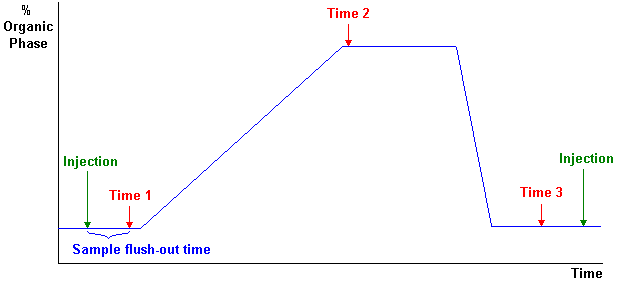Recommendation for automated valve switching times during gradient runs

|
Time 1: |
Valve switch directly after sample has been flushed out at high % water might be useful if sample is highly soluble in water. |
Time 2: | Valve switch at high % organic phase to effectively remove sample from injection valve grooves, while avoiding sample retardation on the column. |
| Time 3: | Valve switch at low % organic phase to effectively remove organic solvent from injection valve groove. |
|
Time 4: |
Used to repeat valve switch 1, 2 or 3 in the case of extremely sticky sample or solvents. |
|
At each time, the valve is switched twice, from bypass to the main flow path to bypass. These additional switches must be taken into account when calculating the number of runs that can be executed until the rotor seal of the injection valve needs to be replaced (EMF). The rotor seal of the WPS has a lifetime of 50-60000 switches; the rotor seal of the μ-WPS has a lifetime of 120000 switches. |
Calculation of Time 1
Time 1 = Sample flush-out factor * Total flush-out volume/Flow rate
Total flush-out volume = Injection volume + Seat capillary volume + Valve volume
Valve volume = 1.7 µL for the G1367A WPS, 80 nL for the G1377A μ-WPS
Seat capillary volume is specified in the Options section of the Configuration panel.
Example:
Flow rate = 2 ml/min = 2000 µL/min
Injection volume = 5 µL
Seat capillary volume = 2.3 µL
Valve volume = 1.7 µL
Sample flush-out factor = 5
Time 1 = 5 * (5 + 2.3 + 1.7)/2000
= 0.0225 min = 1.35 sec.